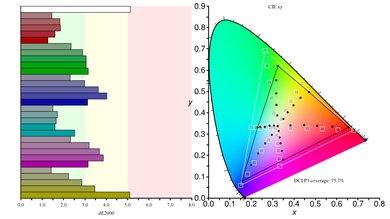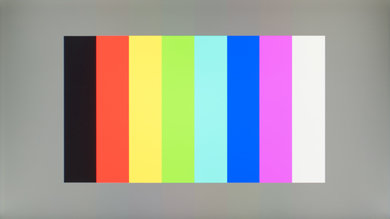The Acer Nitro VG271 Pbmiipx is a good 27" IPS monitor, with a 1080p resolution and 144Hz refresh rate. It has excellent low input lag and outstanding motion handling, making it a great choice for gaming. It delivers decent picture quality overall, with great peak brightness, excellent gray uniformity, and wide viewing angles. Unfortunately, like the majority of IPS monitors, it doesn't look as good in a dark room. It also has a very basic stand, with bad ergonomics, so it might be difficult to place in an ideal viewing position.
Our Verdict
Overall, the Acer Nitro VG271 is a good monitor for most uses. It has wide viewing angles, great peak brightness, and great uniformity. It is a very good monitor for gaming, as it has low input lag and a fast response time. Although it supports HDR, it can't get bright enough and can't display a wide color gamut, so it isn't great for HDR gaming.
-
Excellent low input lag.
-
Outstanding motion handling.
-
Bad ergonomics.
-
Low native contrast ratio and bad black uniformity.
The Acer Nitro VG271 Pbmiip is a decent monitor for office usage. It has wide viewing angles and thin bezels, great for a multi-monitor setup. Although it doesn't look as good in a dark room, this monitor is a great choice for a bright room, as it has great peak brightness and decent reflection handling. The Acer Nitro VG271 has a decent amount of screen real-estate, but the 1080p resolution might disappoint some users. Unfortunately, the stand has bad ergonomics, and it can only tilt.
The Acer Nitro VG271 is a very good monitor for gaming. The fast, 144Hz refresh rate and excellent response time deliver outstanding clear motion, and it supports FreeSync, even from recent NVIDIA graphics cards. There's very little input lag, for an extremely responsive gaming experience. The 1080p resolution might be disappointing for some gamers, though.
The Acer Nitro VG271 is a decent monitor for multimedia. It has wide viewing angles and a large display, great for sharing the latest trends with some friends. It isn't as well-suited for watching movies late at night though, as it can't display deep blacks in a dark room, and it has bad black uniformity. The fast response time delivers outstanding motion, with almost no noticeable blur behind fast-moving objects.
The Acer Nitro VG271 is decent for media creation. The large screen and wide viewing angles make it easier to see your work, but the relatively low native resolution might disappoint some users. The stand has bad ergonomics, and it can't swivel to share the screen with someone standing nearby.
The Acer Nitro VG271 Pbmiip is okay for HDR gaming, mainly due to its very good gaming performance. Unfortunately, the Acer Nitro VG271 can't display a wide color gamut, and can't get bright enough for HDR content to really shine.
- 7.5 Mixed Usage
- 7.3 Office
- 7.9 Gaming
- 7.4 Multimedia
- 7.3 Media Creation
- 6.8 HDR Gaming
Changelog
- Updated Jul 02, 2021: Changed height adjustment result from 'N/A' to '0' to match our methodology.
- Updated Jun 12, 2020: Converted to Test Bench 1.1.
- Updated Jun 10, 2019: Review published.
- Updated Jun 08, 2019: Early access published.
- Updated Jun 06, 2019: Our testers have started testing this product.
Check Price
Differences Between Sizes And Variants
We tested the 27" Acer Nitro VG271, version Pbmiipx, which is the only size available. The Nitro VG271 is part of Acer's Nitro VG1 lineup, which has other models available. We do not expect our review to be valid for the other models.
If someone comes across a different type of panel or if their Nitro VG271 doesn't correspond to our review, let us know and we will update the review. Note that some tests such as the gray uniformity may vary between individual units.
| Model | Part Number | Size | Resolution | Refresh Rate | Notes |
| VG240Y | UM.QV0AA.002 | 24" | 1080p | 75Hz | FreeSync, no HDR |
| VG271 | UM.HV1AA.P02 | 27" | 1080p | 144Hz | FreeSync, HDR |
| VG271UP | UM.HV1AA.P01 | 27" | 1440p | 144Hz | FreeSync, HDR |
The Nitro VG271 we reviewed was manufactured in December 2018.
Popular Monitors Comparisons

The Acer Nitro VG271 is a good gaming monitor but is a bit worse overall than most comparable models. See our recommendations for the best monitors, the best 27 inch gaming monitors, and the best budget monitors.
The Acer Nitro VG271 Pbmiipx and the Acer Nitro VG271UP Pbmiipx are extremely similar. The VG271UP has a higher native resolution, but unfortunately, the unit we tested has terrible black uniformity. The VG271 is significantly brighter in SDR, but there are no other significant differences between these two models.
The ASUS VG279Q is better than the Acer Nitro VG271 Pbmiipx. The ASUS has a much better stand, with a full range of ergonomic adjustments, and it has slightly better black uniformity, but this varies between units. Unlike the VG271, the VG279Q doesn't support HDR, but this doesn't add much on the Acer anyway.
The Acer Nitro VG271 Pbmiipx and the ViewSonic VX2758-2KP-MHD are very similar overall. The ViewSonic has a higher native resolution, making it a better choice for multitasking or gaming, and the unit we tested has better black uniformity. The Acer VG271, on the other hand, supports HDR, although this doesn't add much, and the stand has a slightly better tilt range.
Overall, the Acer Nitro XF243Y is better than the Acer Nitro VG271 Pbmiipx. The XF243Y performs better gaming-wise because it has a much faster response time and a slightly higher refresh rate. The XF243Y is also a better choice for sharing content and co-op gaming due to its wider viewing angles and superior ergonomics. However, the VG271 gets brighter, especially in HDR, and it has a Picture-in-Picture/Picture-by-Picture mode that can be useful for streamers using a second computer to stream.
The Acer Nitro VG271 Pbmiipx is much better than the Lenovo D27-30 for most users. The Acer has much better viewing angles, supports HDR, and is much brighter. The Acer also has a faster refresh rate and a much faster response time, so motion looks much smoother overall. The only advantage of the Lenovo is if you're in a completely dark room, as it has much better black uniformity and better blacks than the Acer.
Although they use different panel technologies, the Acer Nitro VG271 Pbmiipx is much better than the MSI Optix G27C. The Acer uses an IPS panel, and has much wider viewing angles, better gradients, and better motion handling. The Acer also supports HDR, and has an optional black frame insertion feature. The MSI, on the other hand, has better reflection handling.
The Acer Predator XB271HU Bmiprz is slightly better than the Acer Nitro VG271 Pbmiipx for most uses and is much better for gaming. The XB271HU has a much better stand, offering a full range of ergonomic adjustments, and it has better motion handling, with a slightly faster response time. The XB271HU also has a higher resolution screen, so you can see more fine details in your favorite games.
Although they use different panel technologies, the Acer Nitro VG271 Pbmiipx is much better than the Dell S2719DGF. The Acer displays more uniform blacks and supports HDR, great for dark room gaming. It also has wider viewing angles so you can share your screen with a friend, and both enjoy an accurate image. The Dell, on the other hand, has a higher resolution and a TN panel, which is great for gaming. The response time of the Dell is extremely fast, and fast-moving content on your games will appear crisp with almost no blur trail.
Although they use different panel types, the Acer Nitro VG271 Pbmiipx is a bit better than the ViewSonic XG2402. The VG271 has an IPS panel, which has much better viewing angles. The Acer also supports HDR, and has better gray uniformity. The ViewSonic, on the other hand, has a much better stand and a faster response time, although, unlike the Acer, the XG2402 doesn't have an optional black frame insertion feature.
The LG 27GL650F-B is a bit better than the Acer Nitro VG271 Pbmiipx. Although they deliver similar performance overall, the LG has much better ergonomics, and it's officially certfied by NVIDIA as G-SYNC compatible, so FreeSync works automatically when connected to a recent NVIDIA graphics card.
The MSI Optix MAG273R has better ergonomics than the Acer Nitro VG271 Pbmiipx, but if that's not important to you, the Acer has slightly better picture quality and better motion handling. The Acer is brighter, it has a much better response time when gaming at 60Hz, and it's more accurate out of the box.
The Dell S2721HGF and the Acer Nitro VG271 Pbmiipx are both 1080p 144Hz monitors and very similar in terms of gaming performance. The main difference is the panel type. The Dell has a VA panel that makes it a better choice for dark rooms, while the Acer has an IPS panel with wider viewing angles. The Acer is better for bright rooms due to its higher peak brightness, and it supports HDR. Also, it has a faster total response time at 60Hz with less overshoot, making it a better choice for 60fps console gaming.
The Acer Nitro VG271 Pbmiipx is better than the LG 32QN55T-B. The Acer has a much faster refresh rate, resulting in significantly better motion handling, with less blur behind fast-moving objects. The Acer also has lower input lag for a more responsive gaming and desktop experience. On the other hand, the LG has a larger screen, so it's easier to see more of your work at once, and it has better ergonomics.
Test Results
The stand has a great tilt range, but that's it. It can't swivel, and there's no height adjustment. There's no cable management either. For similar budget monitor with better ergonomics, check out the LG 32QN55T-B instead.
The back of the monitor is quite basic. There are vents along the 'v' shaped protrusion on the back, and a VESA mount can be attached directly to the back, without any spacers or adapters. There's a quick-release on the stand, great for mobile professionals that need to move the monitor quickly.
The Acer Nitro VG271 Pbmiipx has a decent contrast ratio, but like most IPS monitors, it doesn't produce deep blacks in a dark room. It also lacks a local dimming feature, which could improve dark room performance. For better dark room performance, check out the MSI Optix G27C or the Lenovo D27-30.
The Acer Nitro VG271 Pbmiipx doesn't have a local dimming feature. The above video is for reference only.
Great peak brightness, very similar to the ASUS VG279Q. This monitor gets bright enough for any room, even if you have a lot of natural light. There's no noticeable variation in brightness with different content, which is great.
Decent peak brightness in HDR, slightly better than the Gigabyte Aorus AD27QD. Small highlights in dark scenes stand out, but in bright scenes they aren't as bright as they should be.
For HDR to work, you have to choose the 'HDR' Picture Mode, and set the HDR setting to either 'Auto', or 'HDR400'. For the purposes of our testing, we chose the 'HDR400' setting.
Like most IPS monitors, the Acer Nitro VG271 has decent horizontal viewing angles. When viewed at wider angles, the black levels remain the same, but the brightness decreases gradually, causing the contrast ratio to decrease and the image to appear washed out. At wider angles, colors lose accuracy.
Like the majority of IPS displays, the Acer Nitro VG271 has very good vertical viewing angles. At moderate angles, colors begin to shift. When looking at the monitor from above, the black levels remain almost constant, but from below, there's a bit more of a noticeable shift in black levels. This is only at very wide angles, though, and shouldn't cause any issues for most people.
Unfortunately, the Acer Nitro VG271 has bad black uniformity. There's noticeable backlight bleed from the corners, and there's clouding throughout the display. These results are worse than the ASUS PG279QZ, but not quite as bad as the Aorus AD27QD.
With the out-of-the-box settings, the Acer Nitro VG271 has decent accuracy. The color temperature is a bit warm, and gamma is relatively flat at 2.2, but still close to the sRGB target curve. The average color error is acceptable, but some colors have noticeable inaccuracies, as do brighter grays.
After calibration, the Acer Nitro VG271 Pbmiipx has excellent accuracy. There are no noticeable errors remaining in any color, and gamma follows the target curve almost perfectly. The color temperature is almost perfect.
You can download our ICC profile calibration here. This is provided for reference only and should not be used, as the calibration values vary per individual unit even for the same model due to manufacturing tolerances.
sRGB Picture Mode: User (calibrated)
Adobe RGB Picture Mode: User
Excellent color gamut, very similar to the ASUS VG279Q. Unfortunately, coverage of the wider Adobe RGB color space might be too limited for professional photo and video editing.
sRGB Picture Mode: User
Adobe RGB Picture Mode: User
Excellent SDR color volume. Like most IPS monitors, it can't display dark saturated colors very well, and like most displays, blues aren't as bright as other colors.
DCI P3 Picture Mode: HDR→ HDR400
Rec. 2020 Picture Mode: HDR→HDR400
The Acer Nitro VG271 Pbmiipx can't display a wide color gamut, which is very important for HDR content. This isn't ideal for HDR gaming or watching movies in HDR.
There are no signs of temporary image retention on the Acer Nitro VG271 Pbmiipx, even immediately after displaying our high-contrast static test image for 10 minutes.
Unfortunately, there are some signs of pixel errors, which is especially noticeable in the vertical columns, where each color extends above and below the block of solid color into the gray area. Although these are noticeable with our test pattern, they aren't noticeable with most regular content.
Decent reflection handling, very similar to the LG 27UD58-B. Reflections aren't diffused very much, and can be distracting in a really bright room with a lot of lights.
Response Time Off
Response Time Normal
Response Time Extreme
The Acer Nitro VG271 has an excellent response time, but it is a bit slower than other 144Hz monitors, like the ASUS VG279Q or Acer Predator XB271HU Bmiprz. There's very little distracting overshoot, but transitions between dark scenes are a bit slower, which can cause more noticeable blur behind fast-moving objects.
There are three options for the response time, but there's very little difference between them. We recommend the 'Extreme' setting, as it delivers the fastest response time with almost no downsides. Unfortunately, this setting isn't available when FreeSync is enabled, resulting in a slightly slower response time. If the Over Drive setting is set to 'Extreme', when FreeSync is enabled it will automatically switch to 'Normal'.
The Acer Nitro VG271 Pbmiipx's backlight is completely flicker-free, which is great. There's an optional Black Frame Insertion feature, which can be enabled by setting the VRB setting to either 'Normal', or 'Extreme'. The above charts were taken with the 'Extreme' setting. The 'Normal' setting, shown here, is a bit brighter, but slightly less effective at reducing persistence blur.
When connected to a source outputting 1080p, the refresh rate must be at least 120Hz for BFI to work.
The Acer VG271 Pbmiipx has an excellent 144Hz refresh rate, great for gaming. It also supports FreeSync, for a nearly tear-free gaming experience, over both HDMI and DisplayPort.
FreeSync also works with the latest NVIDIA drivers, as long as you have a recent 10- or 20- series NVIDIA graphics card, but for NVIDIA cards it only works over DisplayPort.
Like most monitors, FreeSync doesn't work if VRB (Black Frame Insertion) is enabled. When FreeSync is enabled, the 'Extreme' Over Drive setting isn't available, so the response time is a bit slower.
FreeSync is not available when either HDR or VBR (black frame insertion) are enabled.
The Acer Nitro VG271 Pbmiipx has excellent low input lag, even when gaming at 60Hz, great for console gamers. HDR doesn't add any noticeable input lag, but the VRB feature (Black Frame Insertion) is a bit higher, but still great. Both BFI modes (Extreme and Normal) have the same input lag. Non-native resolutions aren't scaled by the monitor, but this shouldn't be an issue for most people, as most graphics cards will scale the image before sending it to the display.
The 27", 1080p display provides a decent amount of screen real-estate, but some people might be disappointed by the relatively low native resolution.
The Acer Nitro VG271 Pbmiipx has a decent selection of inputs, so you shouldn't have any issues connecting your devices. There's an audio out port with adjustable volume, suitable for connecting headphones.
This is a relatively basic monitor, with few additional features. It supports Picture-in-Picture and Picture-by-Picture, and can add virtual crosshairs to any game.
Comments
Acer Nitro VG271 Pbmiipx: Main Discussion
Let us know why you want us to review the product here, or encourage others to vote for this product.












































































































